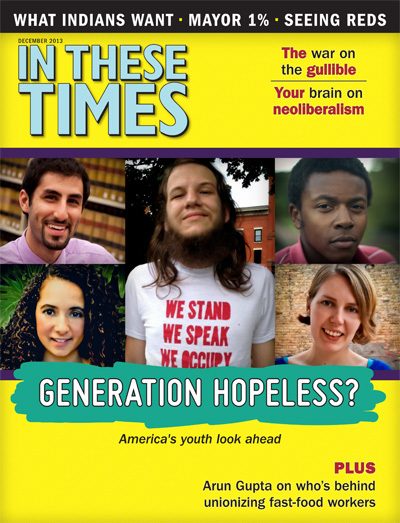Advice For Strategic Planning
A history professor weighs in on how Occupy will bring change.
Susan Levine

For In These Times’ December 2013 cover feature, “Generation Hopeless?”, the magazine asked a number of politically savvy people, younger and older, to respond to an essay by 22-year-old Occupy activist Matthew Richards in which he grapples with what the movement meant and whether Occupy’s unfulfilled promises are a lost cause or the seeds of the different world whose promise he glimpsed two years ago. Here is Susan Levine’s response:
I read Richard’s “Generation Hopeless” with a mixture of sadness and astonishment. Sadness that he feels his singular act of courage and commitment has come to naught and astonishment at how little he seems to understand the history and nature of social movements.
Matthew, read a book! You are disappointed that Wall Street didn’t crumble and capitalism survived the power of the Occupiers’ dreams. How about trying to figure out what it takes to build a social movement over the long haul? You observe that the Civil Rights Movement and the New Left had strong uniting cultures that allowed them to last longer than Occupy. But they also had significant organizational, administrative, political and social infrastructures that connected them in various ways to other institutions and communities — and yes, generations. Neither movement declared defeat after the first — or the fiftieth — time the media ignored them, fellow citizens excoriated them or the police attacked them. If, as you say, Occupy was an “activist boot camp,” well then, you should be in shape for the long march — rather than lamenting the difficult terrain ahead!
Occupy, and the Left in general, is on the one hand more energized and active than ever. Food issues, global warming, surveillance, low-wage work and inequality are motivating organizations and actions every day. At the same time, it is true that the Left is not united, and it is unclear how — or if — all those issuebased groups can come together effectively to form a strategic political movement. When I say strategic political movement, I mean a movement that can articulate common positive goals and can win in communities, in workplaces and at the ballot box. One thing is clear, though, it won’t happen overnight. So I say to Matthew, be patient, think strategically, and remember, it’s not all up to you.





